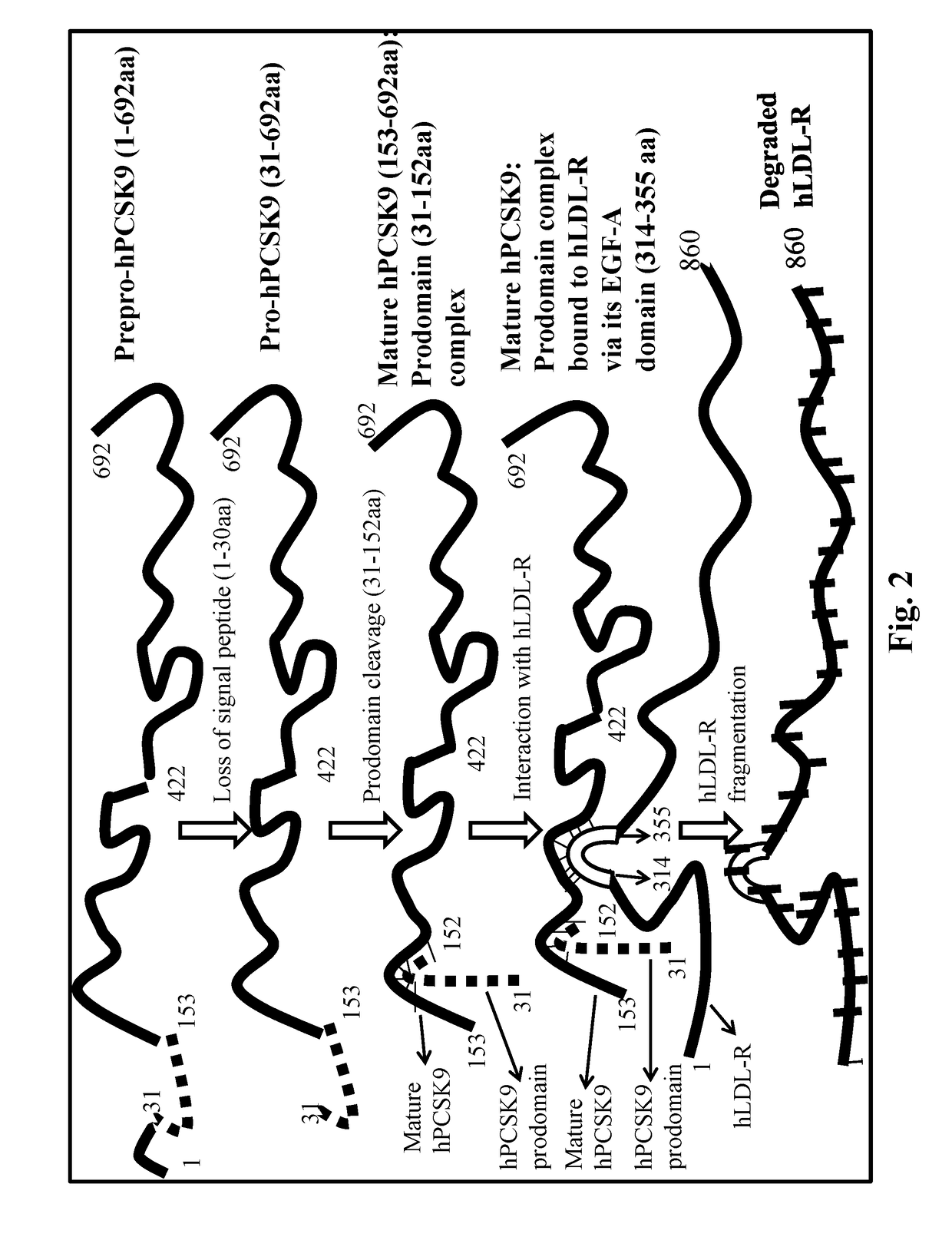Peptides derived from human pcsk9 catalytic domain and uses thereof for promoting ldl-r activity
- Summary
- Abstract
- Description
- Claims
- Application Information
AI Technical Summary
Benefits of technology
Problems solved by technology
Method used
Image
Examples
example 1
Experimental Description
[0104]Materials
[0105]All Fmoc amino terminal protected amino acids (L-configuration) with additional side chain protection as needed, peptide coupling reagents namely HBTU, PAL-PEG-PS resin for peptide synthesis, organic solvents such as Acetontrile (CAN, HPLC grade) and Dimethyl formamide (DMF, analytical grade) were obtained from Bachem Inc (Torrance, Ca, USA), Calbiochem Novabiochem Inc, (San Diego, Ca, USA), Neosystems Inc, (Strasbourg, France) and PE-Biosystems (Foster City, Ca, USA). TFA and all reagents such as phenol, TIS and EDT constituting Reagent B [Palmer Smith H, Basak A. Regulatory Effects of Peptides From the Pro and Catalytic domains of Proprotein Convertase Subtilisin / Kexin 9 (PCSK9) on LDL-R. Curr Med Chem, 17(20):2168-2182, 2010] for peptide deprotection and its cleavage from resin were purchased from Sigma-Aldrich Chemical (Milwaukee, USA). TCEP [Tris (2-carboxy ethyl) phosphine], Iodoacetamide as well as all other coupling agents and org...
example 2
Peptide Design, Purification and Characterization
[0139]hPCSK9 Catalytic Peptides (P1-P51)
[0140]The binding of hPCSK9, a secreted soluble protein with the membrane bound receptor hLDL-R has been the subject of intense investigation in recent years. Studies now revealed that hPCSK9 binds to hLDL-R via the extracellular 42aa long EGF-A domain of the latter that also possesses a strong Ca+2 binding site. Interestingly the precise binding segment of the other partner molecule namely hPCSK9 has not been fully ascertained although all indications point to its catalytic domain (aa153-421). This was finally confirmed by the crystal structures of recombinant hPCSK9 complex with LDL-R or synthetic EGF-A peptide. However which specific peptide sequence / s of PCSK9 catalytic segment is associated with this binding remained unclear.
[0141]In an effort to define this a series of peptides (P1-P51; SEQ ID NOS:1 to 51) of 15 mer length (except the 18-mer last peptide P51) has been designed that encompa...
example 3
In Vitro Binding Study
[0147]hPCSK9 Catalytic Peptides Vs Fl-EGF-A
[0148]Fluorescence Quenching.
[0149]Previously a number of studies reported that the interaction between two ligands one of which is fluorescence labeled can be followed by studying fluorescence intensity. In general the fluorescence intensity is suppressed with or without shift of emission peak position when there is a strong interaction between the two ligands. Greater the suppression or quenching of fluorescence intensity, greater is the strength of binding. In order to further confirm the above notion, a study was carried out by using a fixed concentration of fluorescent biotinylated peptide (IIId) and increasing doses of avidin protein. As more and more avidin binds with biotin (Kd˜10−15 μm), a gradual suppression of fluorescence intensity was observed until it is ˜98% quenched at 8:1 molar ratio of avidin:(IIId) (FIG. 7A). As expected similar results were also obtained with streptavidin (Kd˜10−4 μM), Captavidin (K...
PUM
| Property | Measurement | Unit |
|---|---|---|
| Power | aaaaa | aaaaa |
| Power | aaaaa | aaaaa |
| Power | aaaaa | aaaaa |
Abstract
Description
Claims
Application Information
 Login to View More
Login to View More - R&D
- Intellectual Property
- Life Sciences
- Materials
- Tech Scout
- Unparalleled Data Quality
- Higher Quality Content
- 60% Fewer Hallucinations
Browse by: Latest US Patents, China's latest patents, Technical Efficacy Thesaurus, Application Domain, Technology Topic, Popular Technical Reports.
© 2025 PatSnap. All rights reserved.Legal|Privacy policy|Modern Slavery Act Transparency Statement|Sitemap|About US| Contact US: help@patsnap.com



